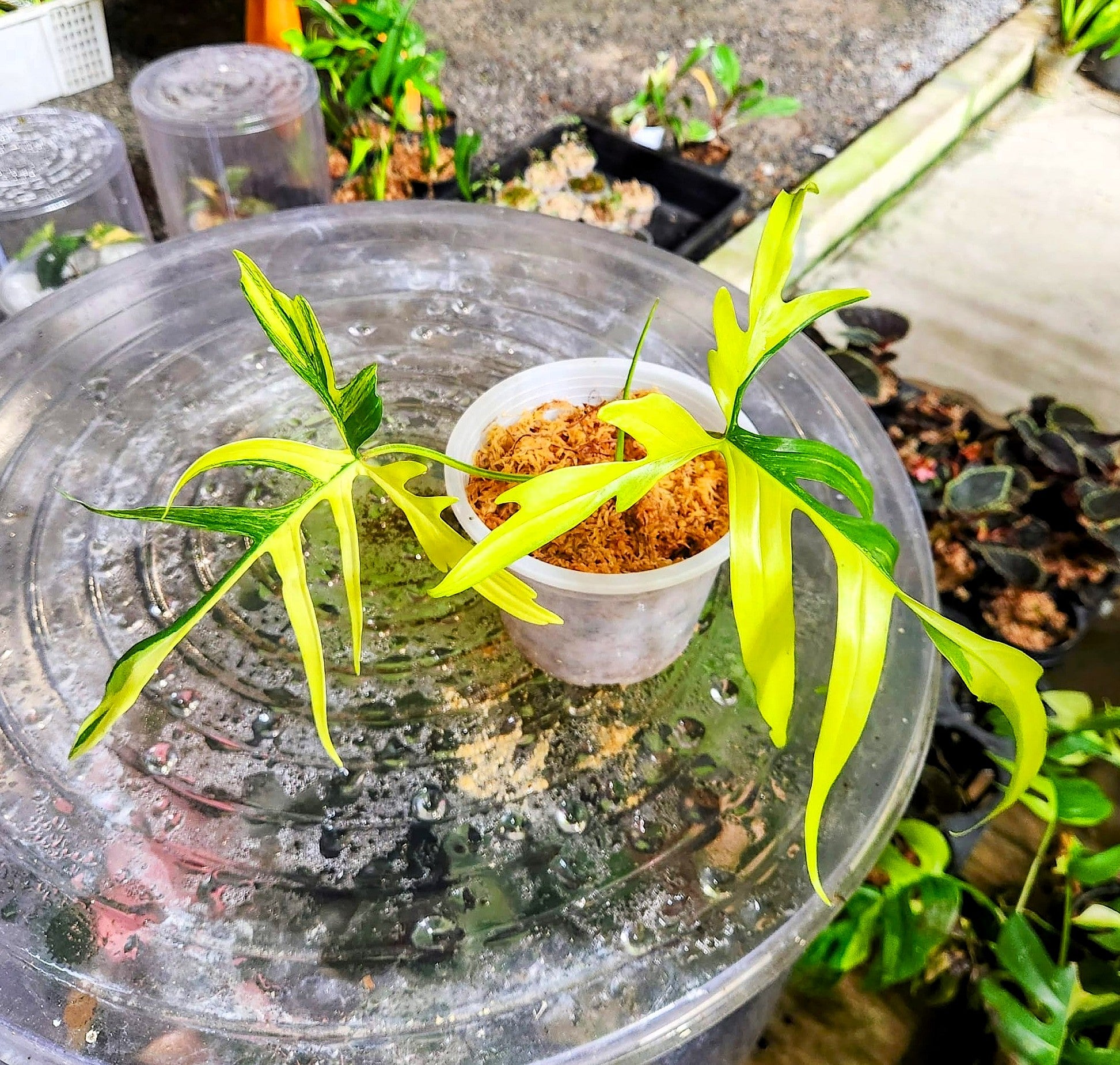
Philodendron Florida Beauty Hybrids: A New Era in Tropical Foliage Breeding
Share
In the world of rare aroid cultivation, few breeding lines have advanced as quickly—or as beautifully—as the Florida Beauty Philodendron hybrids. Over the past two years, these foliage innovations have redefined expectations for leaf morphology, pigmentation, and climbing structure.
Whether you're a serious collector, specialty nursery, or foliage reseller, Florida Beauty hybrids offer an extraordinary range of traits that combine strong market appeal with resilient growth performance.
What Makes Florida Beauty Hybrids So Distinct?
Florida Beauty hybrids are the result of targeted breeding that emphasizes both aesthetic complexity and structural durability. These crosses produce foliage with a broad range of characteristics:
- Multi-lobed or deeply incised leaf shapes
- Uncommon variegation patterns—ranging from cream to orange
- Sculptural growth habits ideal for vertical display
- Strong adaptability to indoor and greenhouse conditions
Many hybrids carry a semi-gloss to high-gloss finish, and some develop vivid petiole coloration, including orange or red tones.
Recent Florida Beauty Hybrids and Their Defining Characteristics
Florida Beauty × Mayoi (AKA - Kitana)

Kitana features dramatic, finger-like lobes with a refined, serrated edge, borrowing structural complexity from Philodendron mayoi. The leaves retain a lustrous finish, amplifying depth and texture as they mature. This hybrid’s climbing nature promotes strong vertical growth, with foliage becoming increasingly defined as new leaves unfurl.
Florida Beauty × Billietiae (AKA - Jennifer)

Broad yet elegantly tapering, Jennifer is one of the more popular Florida beauty hybrids. It is also one of the first Florida beauty hybrids that started showing up in the rare plant market. It merges Florida Beauty’s multi-lobed framework with Philodendron billietiae’s streamlined structure. The distinct veining and yellow variegation forms a eye-catching contrast against its rich green pigmentation. In ideal conditions, Jennifer can sometimes develop orange petioles, setting it apart from other hybrids within this lineage.
Florida Beauty × Black Billietiae (AKA - Brown Beauty)

Unlike standard Florida Beauty hybrids with yellow variegation, Brown Beauty displays an intriguing orangish variegation, highlighting a rare deviation in pigmentation. The dark leaf surfaces further enhance contrast, creating a moody yet sophisticated visual profile.
Florida Beauty × Distantilobium

This Florida beauty hybrid exhibits a robust, structured leaf form that sets it apart from other crosses. The foliage is thick and well-defined, with deep lobes that create a sculptural appearance. The texture is slightly rigid, giving the plant a pronounced presence. Its growth pattern favors symmetry, with each new leaf maintaining a consistent shape and proportion as the plant matures. The venation appears slightly recessed, creating a subtle contrast against the broad green surface.
Florida Beauty × Bob Cee

This hybrid presents elongated, narrow leaves with wavy edges, giving it a refined, flowing appearance. The undulating contours create a sleek, modern aesthetic, differentiating it from more rigid Florida Beauty hybrids. The combination of structured elongation and dynamic yellow variegation makes this hybrid particularly eye-catching as it matures.
Florida Beauty × Paraiso Verde (AKA Aquarius)

A display of ever-changing variegation, this Florida beauty hybrid fluctuates between cream, lime, and yellow tones in both heavy chunks and spattering. The pattern is rarely uniform, ensuring that each leaf emerges with its own distinct coloration. The leaf shape tends to be a perfect blend of each parent species, being both elongated and broad like the paraiso but with some of the lobing that makes the Florida beauty so endearing to collector. Environmental influences play a key role in determining the variegation intensity, making Florida Beauty × Paraiso Verde an intriguing subject for growers interested in light-induced pigmentation effects.
Florida Beauty × Polypodioides

A departure from traditional Florida Beauty structures, the Florida beauty x polypodioides hybrid integrates segmented, fern-like leaf extensions reminiscent of tropical understory plants. The foliage composition allows for enhanced airflow between leaf divisions, producing a lightweight, lacy texture.
Florida Beauty × Tortum

This hybrid introduces an entirely different leaf architecture into the Florida Beauty lineage. The foliage is characterized by narrow, deeply incised segments, creating an almost skeletal effect that emphasizes negative space between each leaf section. The thin, wiry structure allows light to filter through effortlessly, giving the plant a visually lightweight and airy appearance. As it matures, the lobes elongate further, with some specimens developing an almost spindly, web-like framework that appears delicate yet maintains structural integrity.
Florida Beauty × Patriciae

This hybrid stands out due to its elongated, cascading leaves that drape in an almost waterfall-like fashion. Unlike its counterparts with more rigid structures, Florida Beauty × Patriciae develops a fluid silhouette, with foliage that extends and softens at the edges rather than maintaining angular lobes. One of its most distinguishing features is its warm orangish variegation, a rarity among Florida Beauty hybrids, which typically lean toward yellow-toned variegation. Its growth pattern follows a steady climbing habit but maintains a refined, elegant form even as new leaves emerge.
Final Observations
The Florida Beauty hybrid lineage represents a new chapter in Philodendron breeding, showcasing how targeted crosses can produce entirely novel foliage expressions. Each hybrid cross introduces refined leaf morphology, pigment adaptations, and unique growth behaviors—providing both aesthetic intrigue and horticultural research opportunities. Whether drawn to Kitana’s lobed depth, Brown Beauty’s bold contrast, or Florida Beauty × Patriciae’s cascading refinement, these hybrids reveal the exciting future of rare Philodendron cultivation.
If you are ready to add some of these amazing Florida beauty hybrid to your inventory, contact TerraFlora Global today for a price list.
